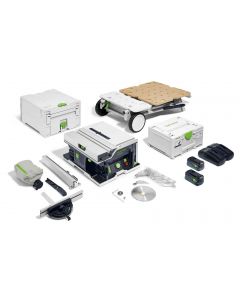
Unleash the power
As the workhorse of any woodworking project, table saws are indispensable. Both seasoned tradespeople and DIY enthusiasts benefit from understanding and mastering the techniques required to achieve precision cuts and efficiency. Whether ripping lumber or crosscutting plywood, there are a few tips and tricks which will make all these tasks easier to navigate. Let’s discuss the essential table saw techniques for construction professionals, which will maximise productivity, minimise errors, and ensure high-quality craft.
THE PERFECT CUTTING STANCE
Once the table saw is set up and you've donned personal protective gear, you're ready to make your first cut. To get any cut right, you must learn how to position yourself for maximum stability and move the workpiece as the blade creates the cut. Ensure your feet are firmly planted, hip-width apart, for stability and to prevent losing your footing. While moving the workpiece through the blade, be careful to keep it steady and flush with the rip fence or adjustable angle stop. Move slowly and steadily, using a push stick to hold the wood if you're stretching to reach the workpiece. Never reach over or across the blade, and never take your eyes off the table saw and your workpiece.
PERFECT RIP CUTS
If you’ve learned to make a cut, you’ve probably already created a rip cut. Rip cuts, made lengthways along the wood grain, are the most straightforward. It is critical to note that the workpiece must be supported by the table saw extensions or the workbench. Without support, you can compromise the finish of your cut and your personal safety.
PERFECT CROSSCUTS
Crosscuts are made across the grain of the wood. Though this cut isn’t difficult, you risk splintering, tear-out, or an untidy finish if your technique isn't correct. To ensure a professional finish, invest in accessories such as a mitre guide or adjustable angle stop. Position the mitre guide in the trench to the left of the blade, holding the workpiece flush against it at a 90° angle to the blade. Move the workpiece through the blade until you have made the desired cut.
PERFECT BEVELS
A bevel cut can be made along the grain of the wood or across it to produce an angled edge. Bevel cuts are commonly seen in picture frames, joinery, and furniture but may be helpful in construction, too. To achieve this, adjust the blade angle away from the standard 90°. Bevel cuts are typically made at a 45° angle, depending on the project requirements. To complete this cut, you will align the fence so that it is parallel to the saw blade and hold the workpiece so that it is flush against the fence while steadily guiding it through the blade.
PERFECT MITRE CUTS
Mitre cuts, made at an angle across the wood grain, are common in joinery, furniture, and construction. To produce a mitre cut, you’ll need an adjustable angle stop also known as a mitre gauge. Before you make your cut, you will set the angle on the angle stop as required. Hold the workpiece flush against the adjustable angle stop, and steadily move the piece through the blade.
If you’re unsure how to adjust the settings for each cut, consult your table saw's manual for more information. Mastering these essential techniques unlocks the full potential of your Festool table saw, equipping you for various woodworking and construction projects.


HOW TO MAINTAIN A TABLE SAW DUST EXTRACTOR FOR OPTIMAL PERFORMANCE
Maintaining your dust extractor is vital to ensure it continues to work effectively. To maintain your table saw dust extractor, you’ll need to clean it and replace the filter bag, if it has a filter bag, and inspect it for damage and leaks. Regularly emptying the dust container is critical for optimal performance and to extend the extractor's lifespan.
Table saw dust collection is crucial to maintaining a clean, safe, and efficient site. Choosing a brand like Festool with high-quality HEPA filters and maintaining it regularly will ensure you maximise your investment. Integrating a dust extractor into your workspace is critical for health and safety, and for providing high-quality, efficient work.
A selection of Festool Table Saws













